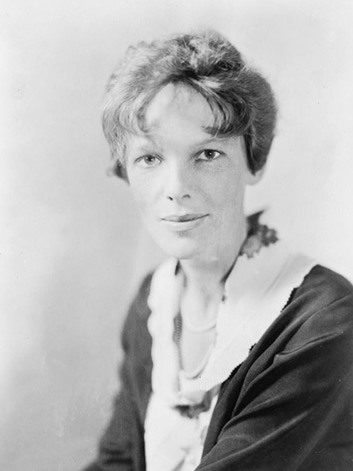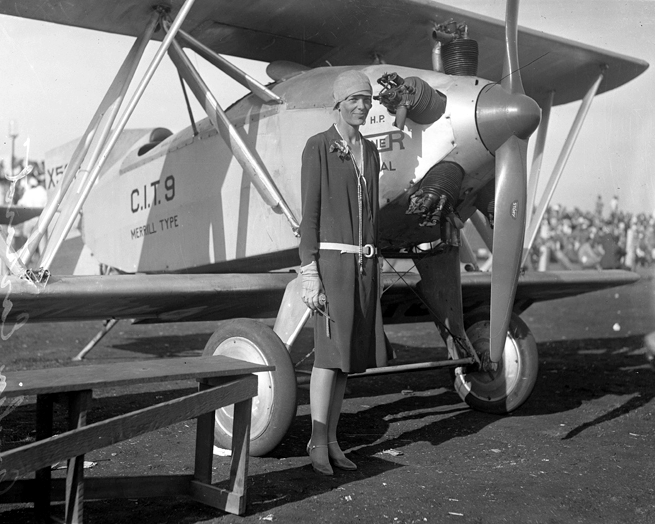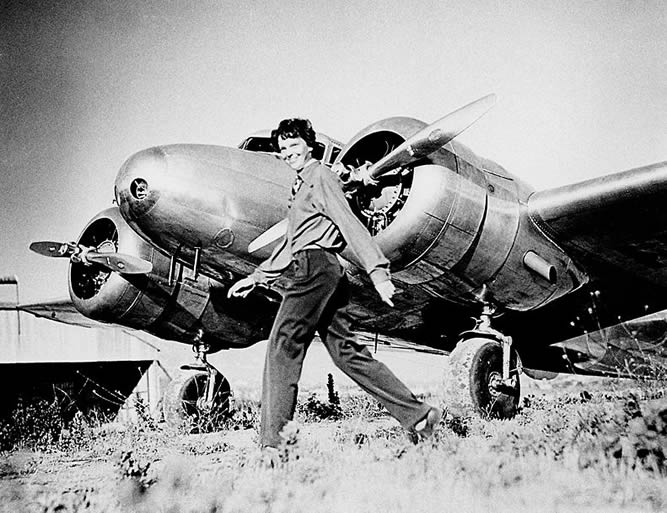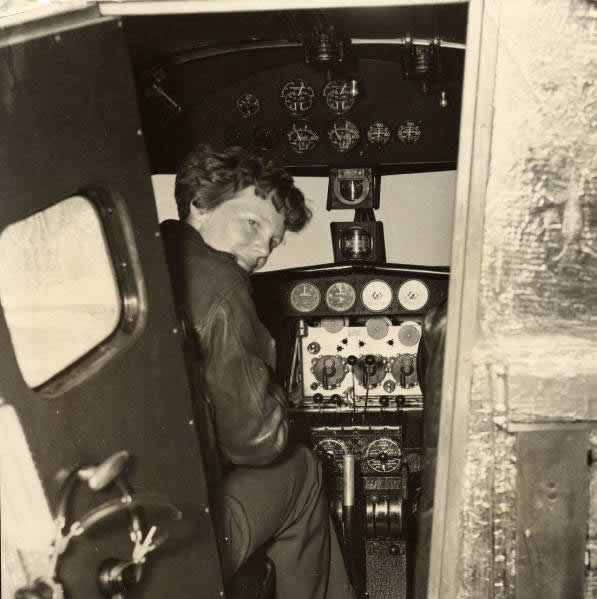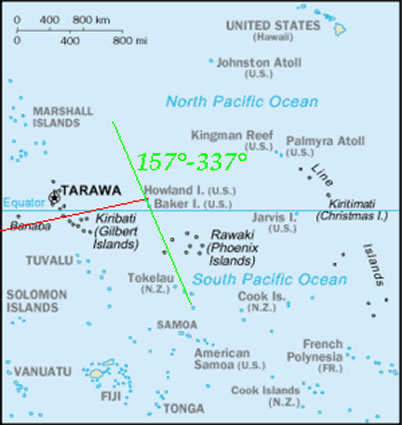AMELIA EARHARTS HISTORY AND DISAPPEARANCE THEORIES
Amelia EarhartAmelia Mary Earhart born July 24, 1897; missing July 2, 1937 was a noted American aviation pioneer and author. Earhart was the first woman to receive the Distinguished Flying Cross, awarded for becoming the first aviatrix to fly solo across the Atlantic Ocean. She set many other records, wrote best-selling books about her flying experiences and was instrumental in the formation of The Ninety-Nines, an organization for female pilots. Earhart joined the faculty of the world famous Purdue University aviation department in 1935 as a visiting faculty member to counsel women on careers and help inspire others with her love for aviation. During an attempt to make a circumnavigational flight of the globe in 1937 in a Purdue funded Lockheed L-10 Electra, Earhart disappeared over the central Pacific Ocean near Howland Island. Fascination with her life, career and disappearance continues to this day. According to the Boston Globe, she was "one of the best women pilots in the United States," although this characterization has been disputed by aviation experts and experienced pilots in the decades since. Amelia was an intelligent and competent pilot but hardly a brilliant aviator, whose early efforts were characterized as inadequate by more seasoned flyers.One serious miscalculation occurred during a record attempt that had ended with her spinning down through a cloud bank, only to emerge at 3,000 ft (910 m). Experienced pilots admonished her, "Suppose the clouds had closed in until they touched the ground?" Earhart was chagrined yet acknowledged her limitations as a pilot and continued to seek out assistance throughout her career from various instructors. By 1927, "Without any serious incident, she had accumulated nearly 500 hours of solo flying – a very respectable achievement."
Throughout this period, her grandmother's inheritance, which was now administered by her mother, was constantly depleted until it finally ran out following a disastrous investment in a failed gypsum mine. Consequently, with no immediate prospects for recouping her investment in flying, Earhart sold the "Canary" as well as a second Kinner and bought a yellow Kissel "Speedster" two-passenger automobile, which she named the "Yellow Peril." Simultaneously, Earhart experienced an exacerbation of her old sinus problem as her pain worsened and in early 1924, she was hospitalized for another sinus operation, which was again unsuccessful. After trying her hand at a number of unusual ventures including setting up a photography company, Amelia set out in a new direction. Following her parents' divorce in 1924, she drove her mother in the "Yellow Peril" on a transcontinental trip from California with stops throughout the West and even a jaunt up to Calgary, Alberta. The meandering tour eventually brought the pair to Boston, Massachusetts where Amelia underwent another sinus procedure, this operation being more successful. After recuperation, she returned for several months to Columbia University but was forced to abandon her studies and any further plans for enrolling at the MIT because her mother could no longer afford the tuition fees and associated costs. Soon after, she found employment first as a teacher, then as a social worker in 1925 at Denison House, living in Medford, Massachusetts. When she lived in Medford, she flew out of Dennison Airport (later the Naval Air Station Squantum) in Quincy, Massachusetts and helped finance it. She also flew the first official flight out of Dennison Airport in 1927. Earhart maintained her interest in aviation, becoming a member of the American Aeronautical Society's Boston chapter and was eventually elected its vice president. She also invested a small sum of money in the Dennison Airport as well as acting as a sales representative for Kinner airplanes in the Boston area. 1928 transatlantic flightAfter Charles Lindbergh's solo flight across the Atlantic in 1927, Amy Phipps Guest, (1873–1959), expressed interest in being the first woman to fly (or be flown) across the Atlantic Ocean. After deciding the trip was too perilous for her to undertake, she offered to sponsor the project, suggesting they find "another girl with the right image." While at work one afternoon in April 1928, Earhart got a phone call from Capt. Hilton H. Railey, who asked her, "Would you like to fly the Atlantic?" The project coordinators (including book publisher and publicist George P. Putnam) interviewed Amelia and asked her to accompany pilot Wilmer Stultz and co-pilot/mechanic Louis Gordon on the flight, nominally as a passenger, but with the added duty of keeping the flight log. The team departed Trepassey Harbor, Newfoundland in a Fokker F.VIIb/3m on June 17, 1928, landing at Burry Port (near Llanelli), Wales, United Kingdom, exactly 20 hours and 40 minutes later. Since most of the flight was on "instruments" and Amelia had no training for this type of flying, she did not pilot the aircraft. When interviewed after landing, she said, "Stultz did all the flying—had to. I was just baggage, like a sack of potatoes." She added, "...maybe someday I'll try it alone." While in England, Earhart is reported as receiving a rousing welcome on June 19, 1928, when landing at Woolston in Southampton, England. She flew the Avro Avian 594 Avian III, SN: R3/AV/101 owned by Lady Mary Heath and later purchased the aircraft and had it shipped back to the United States (where it was assigned “unlicensed aircraft identification mark” 7083). When the Stultz, Gordon and Earhart flight crew returned to the United States they were greeted with a ticker-tape parade in New York followed by a reception with President Calvin Coolidge at the White House. 1932 transatlantic solo flightAt the age of 34, on the morning of May 20, 1932 Earhart set off from Harbour Grace, Newfoundland with the latest copy of a local newspaper (the dated copy was intended to confirm the date of the flight). She intended to fly to Paris in her single engine Lockheed Vega 5b to emulate Charles Lindbergh's solo flight. Her technical advisor for the flight was famed Norwegian American aviator Bernt Balchen who helped prepare her aircraft. He also played the role of "decoy" for the press as he was ostensibly preparing Earhart's Vega for his own Arctic flight. After a flight lasting 14 hours, 56 minutes during which she contended with strong northerly winds, icy conditions and mechanical problems, Earhart landed in a pasture at Culmore, north of Derry, Northern Ireland. The landing was witnessed by Cecil King and T. Sawyer. When a farm hand asked, "Have you flown far?" Amelia replied, "From America." The site now is the home of a small museum, the Amelia Earhart Centre. As the first woman to fly solo non-stop across the Atlantic, Earhart received the Distinguished Flying Cross from Congress, the Cross of Knight of the Legion of Honor from the French Government and the Gold Medal of the National Geographic Society from President Herbert Hoover. As her fame grew, she developed friendships with many people in high offices, most notably, Eleanor Roosevelt, the First Lady from 1933–1945. Roosevelt shared many of Earhart's interests and passions, especially women's causes. After flying with Earhart, Roosevelt actually obtained a student permit but did not pursue her plans to learn to fly. The two friends communicated frequently throughout their lives. Another famous flyer, Jacqueline Cochran, who the public considered Amelia's greatest rival, also became a confidante and friend during this period.
1937 world flightEarhart joined the faculty of Purdue University in 1935 as a visiting faculty member to counsel women on careers and as a technical advisor to the Department of Aeronautics. In July 1936, she took delivery of a Lockheed L-10E Electra financed by Purdue and started planning a round-the-world flight. Not the first to circle the globe, it would be the longest at 29,000 miles (47,000 km), following a grueling equatorial route. Although the Electra was publicized as a "flying laboratory," little useful science was planned and the flight seems to have been arranged around Earhart's intention to circumnavigate the globe along with gathering raw material and public attention for her next book. Her first choice as navigator was Captain Harry Manning, who had been the captain of the President Roosevelt, the ship that had brought Amelia back from Europe in 1928. Through contacts in the Los Angeles aviation community, Fred Noonan was subsequently chosen as a second navigator because there were significant additional factors which had to be dealt with while using celestial navigation for aircraft. He had vast experience in both marine (he was a licensed ship's captain) and flight navigation. Noonan had recently left Pan Am, where he established most of the company's China Clipper seaplane routes across the Pacific. Noonan had also been responsible for training Pan American's navigators for the route between San Francisco and Manila. The original plans were for Noonan to navigate from Hawaii to Howland Island, a particularly difficult portion of the flight; then Manning would continue with Earhart to Australia and she would proceed on her own for the remainder of the project.
Departure from LaeOn July 2, 1937 (midnight GMT) Earhart and Noonan took off from Lae in the heavily loaded Electra. Their intended destination was Howland Island, a flat sliver of land 6,500 ft (2,000 m) long and 1,600 ft (500 m) wide, 10 feet (3 m) high and 2,556 miles (4,113 km) away. Their last known position report was near the Nukumanu Islands, about 800 miles (1,300 km) into the flight. The United States Coast Guard cutter Itasca was on station at Howland, assigned to communicate with Earhart's Lockheed Electra 10E and guide them to the island once they arrived in the vicinity. Final approach to Howland IslandThrough a series of misunderstandings or errors (the details of which are still controversial), the final approach to Howland Island using radio navigation wasn't successful. Fred Noonan had earlier written about problems affecting the accuracy of radio direction finding in navigation. Some sources have noted Earhart's apparent lack of understanding of her Bendix direction finding loop antenna, which at the time was very new technology. Another cited cause of possible confusion was that the USCG cutter Itasca and Earhart planned their communication schedule using time systems set a half hour apart (with Earhart using Greenwich Civil Time (GCT) and the Itasca under a Naval time zone designation system). Motion picture evidence from Lae suggests that an antenna mounted underneath the fuselage may have been torn off from the fuel-heavy Electra during taxi or takeoff from Lae's turf runway, though no antenna was reported found at Lae. Don Dwiggins, in his biography of Paul Mantz (who assisted Earhart and Noonan in their flight planning), noted that the aviators had cut off their long-wire antenna, due to the annoyance of having to crank it back into the aircraft after each use. Radio signalsDuring Earhart and Noonan's approach to Howland Island the Itasca received strong and clear voice transmissions from Earhart identifying as KHAQQ but she apparently was unable to hear voice transmissions from the ship. At 7:42 a.m. Earhart radioed "We must be on you, but cannot see you—but gas is running low. Have been unable to reach you by radio. We are flying at 1,000 feet." Her 7:58 a.m. transmission said she couldn't hear the Itasca and asked them to send voice signals so she could try to take a radio bearing (this transmission was reported by the Itasca as the loudest possible signal, indicating Earhart and Noonan were in the immediate area). They couldn't send voice at the frequency she asked for, so Morse code signals were sent instead. Earhart acknowledged receiving these but said she was unable to determine their direction. In her last known transmission at 8:43 a.m. Earhart broadcast "We are on the line 157 337. We will repeat this message. We will repeat this on 6210 kilocycles. Wait." However, a few moments later she was back on the same frequency (3105 kHz) with a transmission which was logged as a "questionable": "We are running on line north and south." Earhart's transmissions seemed to indicate she and Noonan believed they had reached Howland's charted position, which was incorrect by about five nautical miles (10 km). The Itasca used her oil-fired boilers to generate smoke for a period of time but the fliers apparently did not see it. The many scattered clouds in the area around Howland Island have also been cited as a problem: their dark shadows on the ocean surface may have been almost indistinguishable from the island's subdued and very flat profile. Whether any post-loss radio signals were received from Earhart and Noonan remains controversial. If transmissions were received from the Electra, most if not all were weak and hopelessly garbled. Earhart's voice transmissions to Howland were on 3105 kHz, a frequency restricted to aviation use in the United States by the FCC. This frequency was not thought to be fit for broadcasts over great distances. When Earhart was at cruising altitude and midway between Lae and Howland (over 1,000 miles (1,600 km) from each) neither station heard her scheduled transmission at 0815 GCT. Moreover, the 50-watt transmitter used by Earhart was attached to a less-than-optimum-length V-type antenna. The last voice transmission received on Howland Island from Earhart indicated she and Noonan were flying along a line of position (taken from a "sun line" running on 157–337 degrees) which Noonan would have calculated and drawn on a chart as passing through Howland. After all contact was lost with Howland Island, attempts were made to reach the flyers with both voice and Morse code transmissions. Operators across the Pacific and the United States may have heard signals from the downed Electra but these were unintelligible or weak. Some of these transmissions were hoaxes but others were deemed authentic. Bearings taken by Pan American Airways stations suggested signals originating from several locations, including Gardner Island. It was noted at the time that if these signals were from Earhart and Noonan, they must have been on land with the aircraft since water would have otherwise shorted out the Electra's electrical system. Sporadic signals were reported for four or five days after the disappearance but none yielded any understandable information. The captain of the USS Colorado later said "There was no doubt many stations were calling the Earhart plane on the plane's frequency, some by voice and others by signals. All of these added to the confusion and doubtfulness of the authenticity of the reports."
Crash and sink theoryMany researchers believe the Electra ran out of fuel and Earhart and Noonan ditched at sea. Navigator and aeronautical engineer Elgen Long and his wife Marie K. Long devoted 35 years of exhaustive research to the "crash and sink" theory, which is the most widely accepted explanation for the disappearance. Capt. Laurance F. Safford, USN, who was responsible for the interwar Mid Pacific Strategic Direction Finding Net and decoding of the Japanese PURPLE cipher messages for the attack on Pearl Harbor, began a lengthy analysis of the Earhart flight during the 1970s, including the intricate radio transmission documentation and came to the conclusion, "poor planning, worse execution." Rear Admiral Richard R. Black, USN, who was in administrative charge of the Howland Island airstrip and was present in the radio room on the Itasca, asserted in 1982 that "the Electra went into the sea about 10 am, July 2, 1937 not far from Howland". British aviation historian Roy Nesbit interpreted evidence in contemporary accounts and Putnam's correspondence and concluded Earhart's Electra was not fully fueled at Lae. William L. Polhemous, the navigator on Ann Pellegreno's 1967 flight which followed Earhart and Noonan's original flight path, studied navigational tables for July 2, 1937 and thought Noonan may have miscalculated the "single line approach" intended to "hit" Howland. David Jourdan, a former Navy submariner and ocean engineer specializing in deep-sea recoveries, has claimed any transmissions attributed to Gardner Island were false. Through his company Nauticos he extensively searched a 1,200-square-mile (3,100 km2) quadrant north and west of Howland Island during two deep-sea sonar expeditions (2002 and 2006, total cost $4.5 million) and found nothing. The search locations were derived from the line of position (157–337) broadcast by Earhart on July 2, 1937. Nevertheless, Elgen Long's interpretations have led Jourdan to conclude, "The analysis of all the data we have – the fuel analysis, the radio calls, other things – tells me she went into the water off Howland." Earhart's stepson George Palmer Putnam Jr. has been quoted as saying he believes "the plane just ran out of gas." Thomas Crouch, Senior Curator of the National Air and Space Museum, has said the Earhart/Noonan Electra is "18,000 ft. down" and may even yield a range of artifacts that could rival the finds of the Titanic, adding, "...the mystery is part of what keeps us interested. In part, we remember her because she's our favorite missing person." |
© AviationExplorer.com - The Website For Aviation Enthusiasts |





